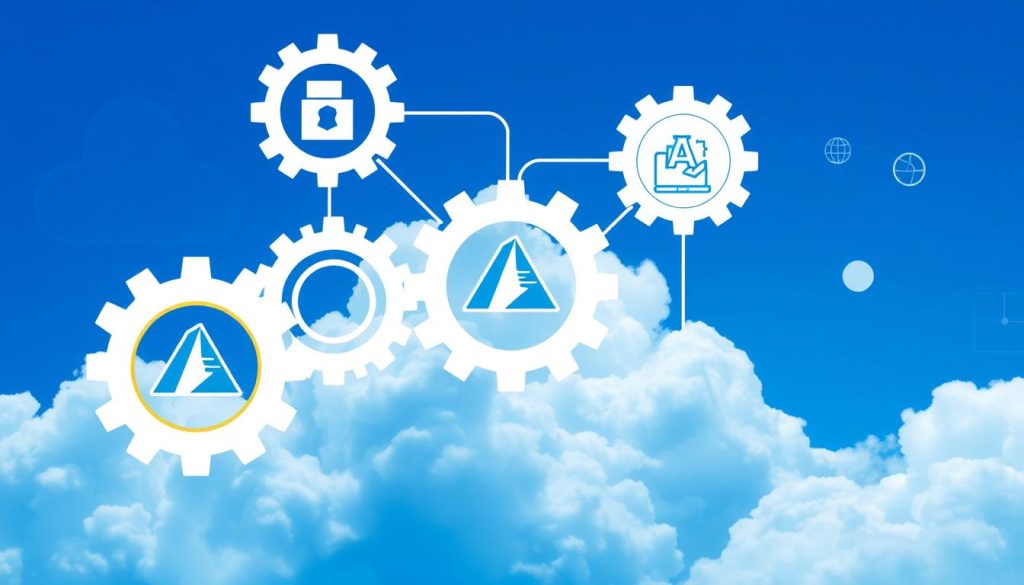AZ-400: Master Build & Release Pipeline Design
Getting ready for the AZ-400 (Design and Implement Build and Release Pipelines) Test certification is a big step in your DevOps journey. This guide will give you the skills and knowledge you need to do well. You’ll learn about continuous integration (CI) and continuous deployment (CD) with Azure Pipelines.
You’ll also find out about the best ways to manage releases. Plus, you’ll understand build automation and infrastructure as code. These are key for the AZ-400 exam.

Key Takeaways
- Understand the CI/CD pipeline process and how to set up Azure Pipelines for your project.
- Discover DevOps practices for efficient release management, including version control, source control management, and infrastructure as code.
- Learn to design and implement build and release pipelines that align with industry standards and prepare for the AZ-400 certification exam.
- Explore techniques for automating the build process and managing infrastructure as code to streamline your software delivery lifecycle.
- Gain insights into the latest trends and best practices in the DevOps field, positioning you as a competent and sought-after AZ-400 certified professional.
Continuous Integration and Continuous Deployment with Azure Pipelines
In today’s fast world, managing build and release processes is key. Continuous Integration (CI) and Continuous Deployment (CD) are crucial DevOps practices. Azure Pipelines, a cloud service by Microsoft, helps implement these practices. It ensures your projects are smoothly integrated and deployed.
Understanding the CI/CD Pipeline Process
The CI/CD pipeline automates software integration and deployment. It includes several stages:
- Source Code Management: Developers update code in a version control system like Git. This keeps all code in one place for teamwork.
- Continuous Integration: When a developer updates code, the CI process kicks in. It builds, tests, and checks the code for problems early on.
- Continuous Deployment: After CI checks pass, CD deploys the software. It goes to a development, staging, or production environment.
Setting up Azure Pipelines for Your Project
Azure Pipelines makes CI/CD easy with its user-friendly interface and many features. To start with Azure Pipelines, follow these steps:
- Link your project’s source code repository (like GitHub or Azure Repos) to Azure Pipelines.
- Set up your build and release tasks with YAML files.
- Add testing and deployment stages, using Azure services and other tools.
- Watch the pipeline’s progress and fix any build or release problems.
Using continuous integration and continuous deployment with Azure Pipelines speeds up your software delivery. It cuts down on manual work and ensures quick, reliable app deployment.

AZ-400 (Design and Implement Build and Release Pipelines) Test
Starting your journey to pass the AZ-400 exam? It’s key to know about designing and implementing build and release pipelines. This test covers software testing, release management, code quality, and infrastructure as code.
To do well, you must show you can set up and manage Azure Pipelines. This tool is great for continuous integration and deployment (CI/CD). You’ll also need to know about testing strategies, version control, and infrastructure automation.
- Learn about the CI/CD pipeline process and how to use Azure Pipelines.
- Understand the role of software testing, including unit, integration, and end-to-end testing. Learn how to add these to your pipelines.
- Discover the importance of release management. Learn how to manage application deployment to different environments.
- Get good at infrastructure as code. Use tools like Azure Resource Manager (ARM) templates or Terraform to manage your cloud infrastructure.
- Know how to monitor and analyze your pipeline’s performance and quality. Use tools like Azure Monitor and Azure Application Insights.
| Concept | Importance |
|---|---|
| Software Testing | Ensures your software applications are quality and stable |
| Release Management | Controls application deployment to different environments |
| Infrastructure as Code | Automates cloud infrastructure provisioning and management |
Mastering these concepts and strategies will prepare you to create strong build and release pipelines. This will help you pass the AZ-400 exam and deliver top-notch software solutions.

DevOps Practices for Efficient Release Management
In the fast-paced world of software development, DevOps is key to better release management. It helps teams work more efficiently and deliver software on time. Version control, source control, build automation, and infrastructure as code are all important in this process.
Version Control and Source Control Management
Version control and source control are the base of a good release strategy. Tools like Git help teams work together, track changes, and keep a project’s history. This makes it easier to fix bugs and roll back changes if needed.
Source control keeps all code in one place, reducing errors and improving teamwork. It makes sure everyone works from the same version of the code. This leads to better code reviews and easier merging of changes.
Build Automation and Infrastructure as Code
Build automation and infrastructure as code are also vital. They make the build process faster and more reliable. This means less chance of mistakes and quicker updates.
By using these DevOps practices, teams can work faster and more reliably. They can deliver updates quicker, with fewer errors. This makes customers happier and more loyal.
Conclusion
In this guide, we’ve covered the AZ-400 test’s key aspects. This will help you excel in your DevOps certification journey. You’ll learn to master Azure Pipelines, adopt CI/CD practices, and use efficient release management strategies.
We’ve looked into continuous integration and deployment. We explored the CI/CD pipeline process and how to set up Azure Pipelines for your projects. We also gave you insights and practical tips for the AZ-400 exam, focusing on “Design and Implement Build and Release Pipelines”.
DevOps practices are crucial, and we’ve highlighted their importance. We talked about version control, source control management, build automation, and infrastructure as code. Using these principles will help you improve your release management, teamwork, and continuous improvement in your organization.
FAQ
What is the AZ-400 (Design and Implement Build and Release Pipelines) test?
The AZ-400 test is a Microsoft Azure certification. It checks your skills in designing and implementing build and release pipelines. This shows you know DevOps practices, Azure Pipelines, and release management well.
What are the key topics covered in the AZ-400 exam?
The AZ-400 exam covers many topics. These include continuous integration, continuous deployment, and Azure Pipelines. It also looks at DevOps practices, release management, and more.
How can I prepare for the AZ-400 exam?
To get ready for the AZ-400 exam, you need to know the key concepts well. You should also have hands-on experience with the technologies involved. This includes mastering Azure Pipelines and CI/CD practices.
What are the benefits of obtaining the AZ-400 certification?
Getting the AZ-400 certification shows you’re skilled in designing and implementing build and release pipelines. This is very valuable in the DevOps field. It can boost your career, increase your pay, and make you a top DevOps professional.
How can I set up Azure Pipelines for my project?
To set up Azure Pipelines, first create an Azure DevOps organization. Then connect your source control repository, like Git. Azure Pipelines has a user-friendly interface and templates to help you start quickly.
What are the best practices for effective release management?
Good release management includes version control, source control management, and build automation. It also involves infrastructure as code. These practices help ensure reliable software deployments and maintain code quality.
How can I improve my software testing capabilities for the AZ-400 exam?
To improve your testing skills, learn and apply different testing methods. This includes unit testing, integration testing, and end-to-end testing. Also, get to know tools and frameworks that automate and streamline testing.